Heavy Gold Coins – A Special Gift for Special People Courtesy of Numismatica Genevensis
Have you ever wondered why there were so many large gold coins weighing several ducats in the early modern period?
Have you ever wondered why there were so many large gold coins weighing several ducats in the early modern period? We’ll show you with the help of some spectacular examples from the upcoming Numismatica Genevensis auction.
It’s easy to forget that in the early modern period, coins weren’t used as we use them today. For us, a coin is either a means of payment or an object of commemoration, but back then, it could also serve as a gift, among other things. The term ‘gift’ is used in sociology to describe a phenomenon that oscillated between ritual bargaining chip, reward, tip, bribe, travel expenses allowance and propaganda tool.
Too theoretical? Let’s take a look at some practical examples of this phenomenon, using the spectacular large gold coins that Numismatica Genevensis will be presenting at its auction on 15 and 16 November.
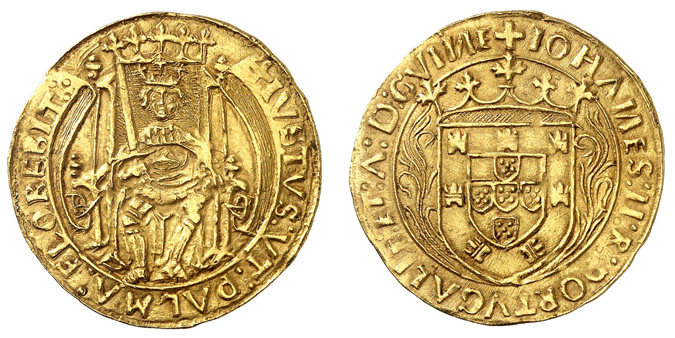
Portugal. João II. 1481-1495. Justo of 600 Reais, undated (1489-1495), Lisbon. NGC MS63. Extremely fine. Estimate: CHF 150,000. From Auction Numismatica Genevensis 14 (15 and 16 November 2021), Lot 377. [Dm 31.0mm]
Where Did the Gold Come From?
First of all, let’s ask ourselves an important question: where did the gold for these coins actually come from? After all, although a wide variety of medallions has been handed down from ancient Rome, such pieces disappeared entirely from the Central European region with the end of the Migration Period. This was caused by the loss of access to the rich gold mines of Africa due to the expansion of Islam. The production of such medallions did not resume until enough gold became available again during the course of the early modern period.
Portugal, which had conducted its expeditions around Africa not out of scientific curiosity, but rather in pursuit of profit, became the leading importer of gold. In 1482, the Portuguese founded the trading emporium of São Jorge da Mina on the Gold Coast in what is now Ghana, doubling the crown’s income in one move. Now, Portugal could enjoy access to a constant supply of gold, which, at first, had a lasting impact on its own currency. João II redesigned the Portuguese coinage system. In addition to the cruzado, he also introduced the justo, worth 600 reais, which Numismatica Genevensis will be presenting in Auction 14. The justo had twice the value of the cruzado, which came before it. And that was just the first step. In 1499, Manuel I created the golden português. Portugal’s trading partners not only imported this particular coin – they also imitated it: with their own portugalesers.
But these turned out not to be suitable for trade. People preferred to pay large sums with bills of exchange, which could be transported risk-free. But as a form of savings and especially in diplomatic dealings, these large gold coins became a huge success.
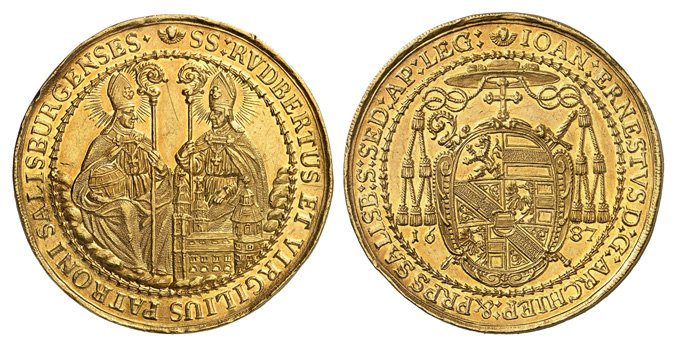
Salzburg. Johann Ernst, 1687-1709. 12 ducats 1687. Extremely fine. Estimate: CHF 40,000. From Auction Numismatica Genevensis 14 (15 and 16 November 2021), Lot 225. [Dm 45.8mm]
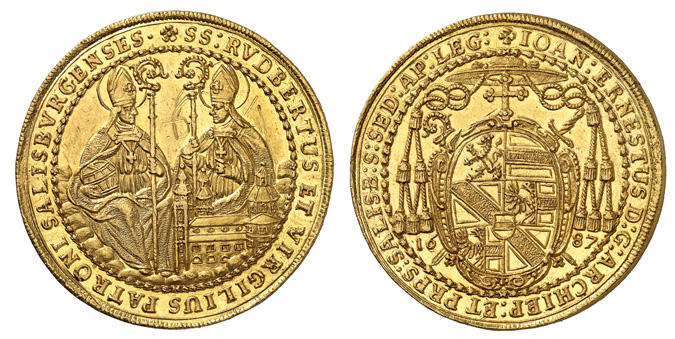
Salzburg. Johann Ernst, 1687-1709. 6 ducats 1687. NGC UNC DET. Estimate: CHF 15,000. From Auction Numismatica Genevensis 14 (15 and 16 November 2021), Lot 226. [Dm 37.0mm]
Big Gold Coins for Big Celebrations
Let’s take a look at a typical case of a ruler minting heavy coins: in 1687, Johann Ernst von Thun und Hohenstein issued a series of gold coins in various weights. Numismatica Genevensis will be presenting two versions of this issue: one weighing 6 ducats and another weighing 12. The reason these coins were minted is easy to guess if you know that every bishop’s inauguration was marked with a great celebration.
On 30 June 1687, Johann Ernst von Thun und Hohenstein was elected as the 58th Archbishop of the wealthy city of Salzburg and, on 24 November in the same year, he was confirmed in his office by the Pope. At that point, if not before, his inauguration ceremony took place, with a large church service followed by festivities. All those who had diplomatic relations with the bishop sent their representatives to attend this ceremony, who were officially received by the bishop. An integral part of this ceremony was the exchange of gifts.
The value of a gift was subject to precise rules: its value was determined primarily by the rank of the recipient; the higher their rank, the greater the gift. These considerations also took into account the gift presented by the other party. After all, giving a more valuable gift was another way of demonstrating one’s higher rank. Last but not least, it was also a matter of political support. Who had voted for the bishop? Whose support would he be able to count on in future? Such services were also considered when calculating the value of a gift.
It was therefore an enormous feat of diplomacy to ensure that everyone was given the appropriate gift. In order to prepare exactly the right gift for these occasions, bishops in the early modern period preferred to mint coins in various metals and weights. These could be graded precisely and their value could be measured exactly.

Salzburg. Franz Anton von Harrach, 1709-1727. 10 ducats 1709. NGC MS62+. Estimate: CHF 125,000. From Auction Numismatica Genevensis 14 (15 and 16 November 2021), Lot 227. [Dm 46.0mm]
As mentioned above, every new bishop celebrated their assumption of office, and those who could afford it had a special issue of coins minted for the occasion, which then served as ceremonial gifts. This practice was also observed by Johann Ernst’s successor Franz Anton von Harrach. He had been elected coadjutor to the archbishop, and therefore the latter’s successor, on 19 October 1705. On 27 May 1709, his election was confirmed by the Pope, which meant that Franz Anton von Harrach could celebrate with his own great inauguration ceremony, where he bestowed large gold coins upon those who attended.

Salzburg. Wolf Dietrich von Raitenau, 1587-1612. 25 ducats 1594, Salzburg. Extremely fine +. Estimate: CHF 250,000. From Auction Numismatica Genevensis 14 (15 and 16 November 2021), Lot 222. [Dm 41.8mm]
Large Gold Coins as a Tip and as a Tool of Propaganda
Wolf Dietrich von Raitenau had already taken office back in 1587. His ‘Turmprägungen’ (‘tower coins’) from 1594 were therefore not minted as gifts for guests arriving to congratulate him. They had an entirely different purpose.
The image that is depicted on these ‘Turmprägung’ coins, and which gave them their name, has long been associated with the Long Turkish War, which kept the Imperial states busy between 1593 and 1609. The wind-battered tower in a thunderstorm, combined with the Latin inscription ‘I hope in God and will not falter’, was often interpreted as the embodiment of Christian victory over the Ottomans. However, this interpretation contradicts Wolf Dietrich von Raitenau’s political agenda in 1594.
He was the most vocal opponent of the Habsburg ruler during the Imperial Diet of 1594, where Rudolf II more or less illegally enforced the ‘Turkish tax’. This was a tax that the Imperial states would have to pay in order to finance a war that was not taking place on Imperial territory, but rather on the borders of the Habsburg Hereditary Lands. The Bishop of Salzburg, Wolf Dietrich von Raitenau, refused to pay these taxes. This could well have resulted in a trial before the ‘Reichskammergericht’ (Imperial Chamber Court) – as it had in the case of the numerous Protestant tax resisters. But Wolf Dietrich was a shrewd diplomat. Back in 1593, he had sent a small troop to support the Imperial Army; these soldiers did not get involved in any battles, but they kept up appearances. Wolf Dietrich could say that he had voluntarily (!) sent the auxiliary troops to the emperor, while the emperor could forego what would have been a rather embarrassing accusation against the Bishop of Salzburg before the Imperial Court, since he had made some kind of contribution, after all.
The ‘Turmprägungen’, which were minted in both gold and silver, as well as in a wide variety of weights, served initially as a bonus payment to supplement the salaries of the Salzburg soldiers fighting in the Turkish War, with the coins’ value corresponding to the respective rank. At the time, it was quite common for a satisfied prince to present his soldiers with a gift of honour in addition to their agreed salary.
We can also assume that more valuable specimens were sent to the opinion leaders of the 1594 Imperial Diet as diplomatic gifts. They served to highlight the position taken by the Bishop of Salzburg, namely that no Turkish War would bring him to bend Imperial law.
He was in the minority with this view, by the way. The majority was prepared to obey the emperor, even though he convened Imperial Diets again in 1598 and 1603 to raise even higher Turkish taxes. In total, the Imperial states approved almost 29 million gulden to finance the Habsburgs’ wars.
The Protestant and especially the Calvinist princes refused to pay their dues for a long time. The Bishop of Salzburg took their side of the argument. This was an unusual combination that explains why Maximilian of Bavaria, the Habsburgs’ closest ally in the Thirty Years’ War, succeeded so easily in removing the prince-bishop, along with his critical views of the emperor, in 1611.
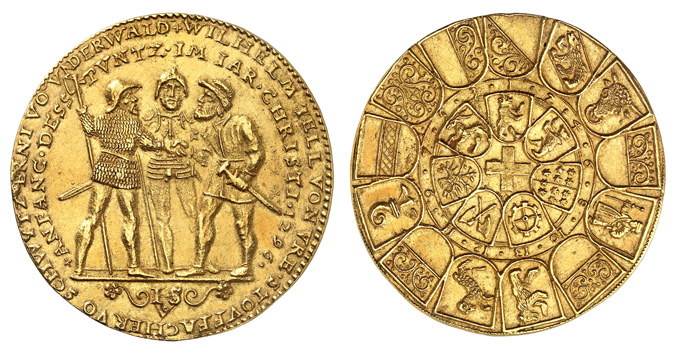
Switzerland. Gold medal weighing 5 ducats by J. Stampfer, Zurich. Extremely fine. Estimate: CHF 40,000. From Auction Numismatica Genevensis 14 (15 and 16 November 2021), Lot 387. [Dm 41.3mm]
Commemorative Coins as Diplomatic Gifts
This custom of giving heavy gold and silver coins as gifts in the course of diplomatic dealings was also practised in Switzerland. For example, in his biography of Ludwig Pfyffer, Philipp Anton von Segesser tell us that in 1582, following the signing of the mercenary contracts, the French envoy presented the delegates of the Three Leagues with heavy gold chains, each adorned with a gnadenpfennig. Here, Segesser is referring to the oldest evidence of this custom, which was later practised regularly. The absence of any earlier sources has led many to conclude that it hadn’t existed prior to this. But couldn’t it be the other way around? Couldn’t this custom have already existed without being mentioned in the sources? There is a coin and an occasion that would fit this theory.
Let’s go back to 1547: on 31 March, Francis I of France died. This meant that the French mercenary contracts with the Swiss confederates had to be renegotiated, as they expired exactly three years after the death of the signing king. His successor Henry II used the birth of his daughter Claudia on 12 November 1547 as an opportunity to establish relations with the ‘Tagsatzung’ (Federal Diet of Switzerland). He asked the confederates to be her godparents. They expressed their interest in friendly relations with France by sending three emissaries to the baby’s christening. They brought with them a gift that Johann Jakob Stampfer had produced on behalf of the Tagsatzung: a heavy patenpfennig worth 300 crowns (Swiss coin of account). This piece depicted the coats of arms of the 13 Swiss confederates on one side and those of the seven ‘Zugewandte Orte’ (associated states) on the other.
Two years later, the emissaries of the Tagsatzung travelled back to Paris, where, on 7 June 1549, they signed new mercenary contracts with Henry II. And at around the same time, Johann Jakob Stampfer produced the ‘bundestaler’, which, just like the medal described above, depicts the coats of arms of the confederates and of the associated states, but this time all together on one side. The other side is reserved for the ‘Rütlischwur’ oath. The reason Stampfer produced this coin is entirely unknown. Perhaps he did not have any clients and was selling these medals privately to his contemporaries? This is not very likely, especially when we consider what a wonderful coin design the oath of the original Swiss cantons would have been to celebrate the alliance with France.
It is therefore perfectly possible that this object also served as a diplomatic gift, and that the silver and smaller gold versions that we know today were given to all those in the delegation.
One real argument in support of this theory would be the fact that the Royal Coin Cabinet of France – as Gottlieb Emanuel Haller writes in his 1780 work ‘Schweizerisches Münz- und Medaillenkabinett’ (‘Swiss Coin and Medal Cabinet’) – featured a gold version weighing over 60 grams. Haller writes: ‘The coin is the size of a thaler and is found in almost every canton. ... Weighing 2 ounces, 1/2 gros and 18 grains in gold in the Royal Coin Cabinet in Paris and the Escher Cabinet in Zurich.’
However, we cannot (yet) prove beyond a doubt that the bundestaler served as a diplomatic gift at the signing of the mercenary contracts. But we have not yet exhausted all the historical sources. When it comes to numismatics in the early modern period, there is still much more to be discovered.
Knowledge about the role of coins as diplomatic gifts was lost over time, to such an extent that, on pages 439-442 of his 1789 journal ‘Monatlichen Unterredungen einiger guter Freunde’ (Monthly Conversations Among Good Friends), Saxon numismatist Wilhelm Ernst Tentzel had to seriously ponder whether Wilhelm Tell, Werner Stauffacher and Arnold von Melchtal (the figures depicted on the bundestaler) could have commissioned this coin themselves.

Download the Greysheet app for access to pricing, news, events and your subscriptions.
Source: CDN Publishing


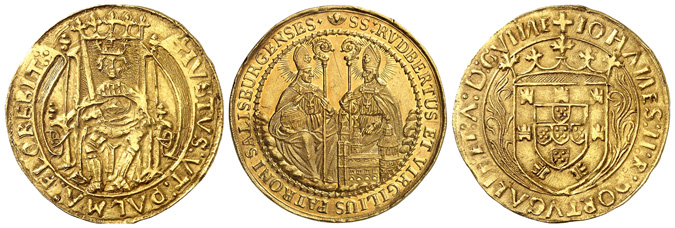
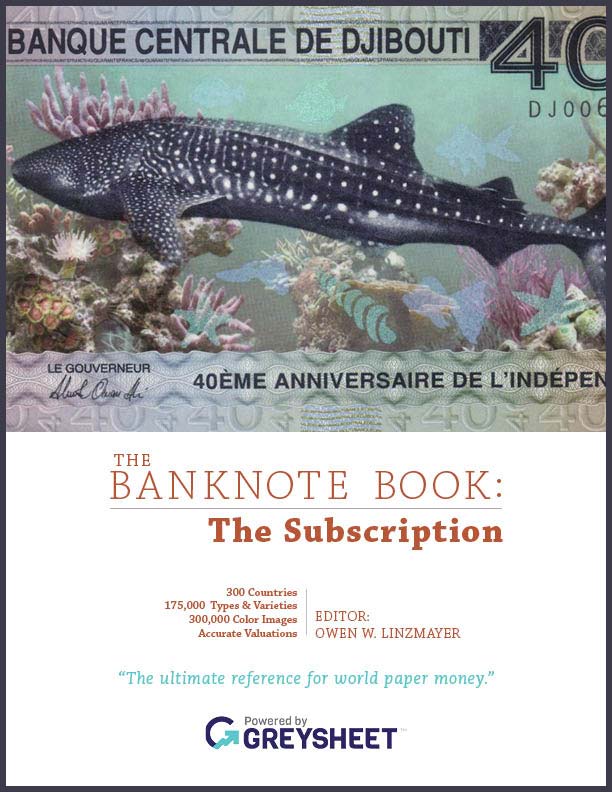








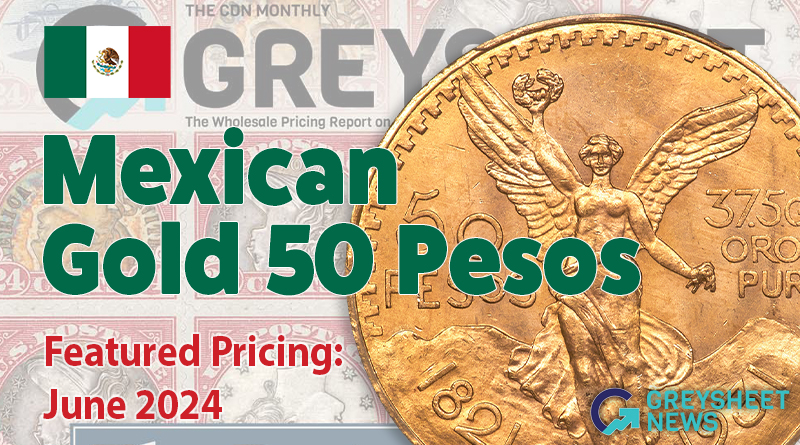
Please sign in or register to leave a comment.
Your identity will be restricted to first name/last initial, or a user ID you create.
Comment
Comments